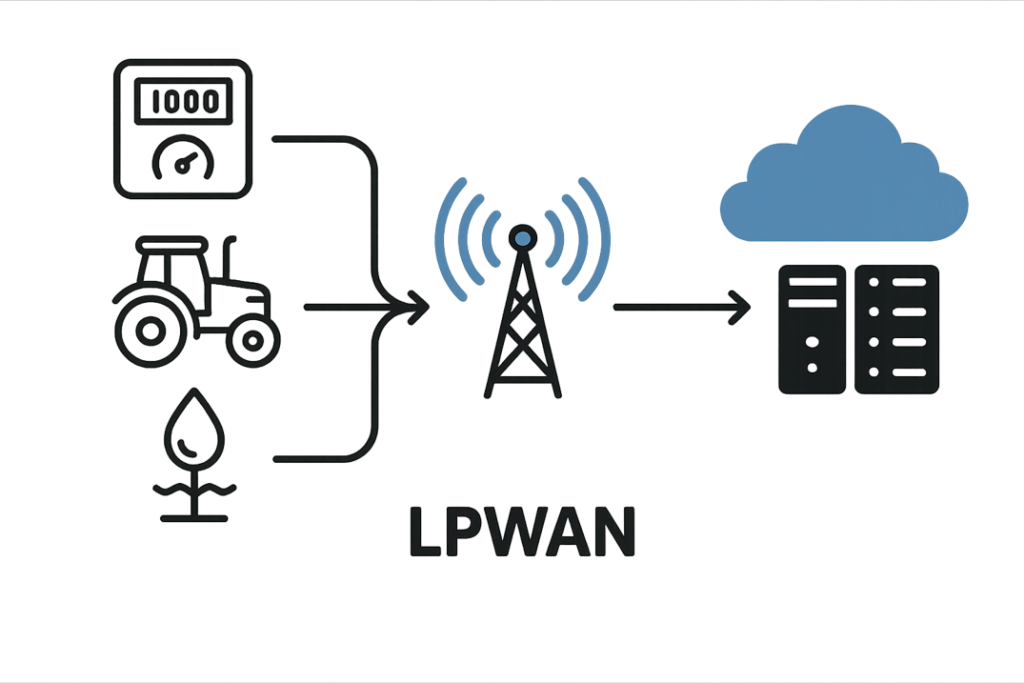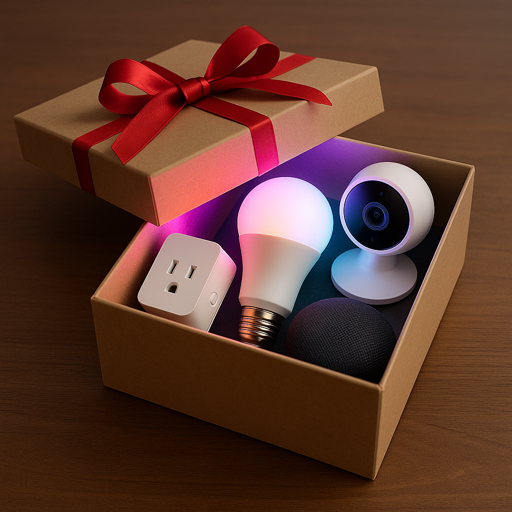This post may contain affiliate links. If you click through and make a purchase, we may earn a commission at no additional cost to you. This helps support our work and allows us to continue providing valuable content. For more information, please see our disclosure policy.

If you’ve ever wondered how small sensors monitor fields of crops, track shipping containers across continents or gather data in remote areas without burning through battery power, I can tell you LPWAN is a big part of the answer. LPWAN stands for Low Power Wide Area Network and it’s designed to connect Internet of Things (IoT) devices that need to transmit small amounts of data over long distances, all while conserving battery life.
This guide will take you through what LPWAN is, why it matters, and how you can harness it for your own IoT projects.
Understanding LPWAN IoT Basics
LPWAN is a set of network technologies that focus on long range communication using minimal power. Think about sensors dotted around a massive farm or tagging livestock in fields miles apart. Those devices need to send small data packets (maybe soil moisture readings or GPS coordinates, for example) without relying on the electrical grid. LPWAN provides the coverage and energy efficiency required to do exactly that.
The Fundamentals of Low Power Networking
In many traditional wireless networks, speed is king. However, LPWAN flips the script by intentionally limiting throughput. Typical data rates range from 0.3 kbit/s to about 200 kbit/s, depending on the specific technology. This slower speed is a reasonable trade off when your device only needs to send sensor readings every hour or so. Here’s are some key components of this remarkable technology:
- Low bit rates: Support small data packets at infrequent intervals.
- Extended coverage: Operate across distances ranging from a couple to of kilometers to tens of kilometers in certain scenarios.
- Low power draw: Let devices run for years on simple batteries.
Why Low Power Usage is So Important
Imagine you’re installing temperature sensors in a remote greenhouse. You might not have convenient outlets or maybe you need the sensors to last for months without human intervention. This is where LPWAN excels. Reports show that certain IoT devices connected via LPWAN can run 10 years or more on battery alone, since they mostly sleep and wake up only to send data.
The Difference Between LPWAN and Other WANs
Traditional wireless wide area networks like 4G or public Wi-Fi are designed to handle higher throughput. They usually support video streaming, voice calls and real-time apps. On the contrary, LPWAN is built around the needs of small, battery powered IoT devices. You won’t be streaming HD video, but you’ll likely need to send crucial sensor data reliably over long distances with minimal battery drain.

Key LPWAN Technologies
There’s no single silver bullet in the LPWAN world. Instead, you’ll find a handful of technologies, each with its own coverage range, data rate, licensing model and typical use cases. Let’s explore a few of the major players.
Sigfox
Sigfox is a proprietary LPWAN technology known for extremely low bandwidth and power consumption. It uses ultra narrowband (UNB) modulation and covers distances of:
- 30–50 km in rural areas
- 3–10 km in urban settings
Sigfox does have its limitations, however, and can only transmit around 140 messages per day, with each message capped at 12 bytes. That said, Sigfox is still great for applications that transmit tiny amounts of data on an infrequent schedule, like location pings or basic sensor updates.
LoRa and LoRaWAN
LoRa (short for long range) is the physical layer technology, while LoRaWAN defines the network protocol. They operate in the sub-gigahertz frequency bands, which reduces interference and extends range. LoRaWAN can handle packet sizes from about 10 to 243 bytes (larger with fragmentation) and typically operates between 2 km and 15 km, although it can reach farther in ideal conditions. It’s an attractive option if you want to set up a private network, since you can deploy your own gateways and keep everything in-house.
NB-IoT (Narrowband IoT)
NB-IoT uses existing LTE or GSM infrastructure, so it’s often rolled out by mobile operators. It offers:
- Typical data rates of around 26 kbit/s uplink and 66 kbit/s downlink
- Very narrow bandwidth of 200 kHz
- Extended battery life of 10 years or more
Because NB-IoT leverages cellular networks, it usually comes with strong security features like SIM authentication. This technology is particularly popular in smart city implementations when coverage and reliability are essential.
LTE-M
Like NB-IoT, LTE-M runs on existing cellular infrastructure. However, it has a slightly higher data rate, suitable for applications that need a bit more throughput (like voice or firmware updates). It still focuses on power saving features such as Power Saving Mode (PSM) and Discontinuous Reception (DRX), which let devices sleep for extended periods.
Weightless
Weightless SIG has released multiple standards:
- Weightless-N: very low power, one-way uplink (~100 bps)
- Weightless-P: bidirectional, ~100 kbps
- Weightless-W: wideband, up to 10 Mbps (rarely used today)
While technically capable, Weightless technologies have seen minimal commercial adoption and are largely considered obsolete in today’s LPWAN market, with most deployments focusing on LoRaWAN, NB-IoT and LTE-M instead.
A Quick LPWAN Technology Comparison
To see how these technologies stack up against one another, here’s a concise comparison:
A Quick LPWAN Technology Comparison
| Technology | Frequency Band | Typical Range (rural) | Data Rate (approx.) | Typical Battery Life* | Notable Feature |
|---|---|---|---|---|---|
| Sigfox | Unlicensed sub-GHz (868/902) | 3–50 km | ~100–600 bps | 5–10 years | Ultra-low power, strict message limits |
| LoRaWAN | Unlicensed sub-GHz (EU868/US915) | 2–15 km+ | 0.3–50 kbps | 5–10+ years | Flexible: private or public networks |
| NB-IoT | Licensed LTE spectrum | Up to 20+ km | ~26–66 kbps (up to 250 kbps) | 5–10 years | Deep coverage, SIM-based security |
| LTE-M | Licensed LTE spectrum | ~10–15 km | ~300 kbps (up to 1 Mbps) | 3–5 years | Mobility, voice (VoLTE), global roaming |
| Weightless | Sub-GHz (licensed/unlicensed) | ~2–10 km | 100 bps – 100 kbps (varies) | 3–8 years (variant-dependent) | Flexible standards, niche adoption |
* These are indicative lifetimes under light duty IoT use cases (like sending a few messages per day with sleep cycles enabled)
Note that performance can vary depending on environment, line-of-sight and local regulations. Still, this table should give you a rough idea of where each LPWAN standard might fit.
Common Use Cases
LPWAN technologies have found their way into a wide variety of settings. Whenever you need to deploy sensors across a large area, relay small bits of data or run on battery power for years, LPWAN is your go-to solution.
Smart Agriculture
If you grow crops that span hundreds of acres, you might use sensors to track soil moisture, temperature or pest related data. LPWAN’s long range connectivity ensures those sensors can beam data back to a central gateway or the cloud. More advanced setups even allow you to automate irrigation or fertilization. In livestock monitoring, LPWAN tags report location and vital signs, helping you spot potential health or feeding issues early.
Smart Cities
Cities use LPWAN for common applications such as:
- Waste management, where dumpsters report fill levels.
- Smart lighting, where street lights adjust brightness based on real-time conditions.
- Parking sensors, which let drivers find open spots without circling the block.
Because LPWAN is low power, city governments can maintain these sensors without frequent battery changes, saving both time and labor.
Industrial IoT and Logistics
Factories often install sensors on production lines to monitor equipment health or track parts as they move from station to station. If you run a logistics operation, maybe you want to track shipping containers across long distances. Industrial devices using LPWAN can send simple status updates or location data reliably. Even if these sensors are outdoors or far from electrical outlets, you can still stay in the loop on your assets’ locations.
Healthcare and eHealth
It is crucial that wearable health monitors or remote patient monitoring systems maintain connectivity without draining batteries. With LPWAN, these devices can send essential health measurements like heart rate and activity levels, while sparing you from daily charging. In large facilities, doctors and nurses can track critical equipment or patients in real-time, ensuring better care.
Understanding Development Challenges
Before jumping in, you should know that LPWAN deployments come with unique hurdles. It’s not all plug-and-play when it comes to optimizing battery life, ensuring security or deciding on the right hardware for your project.
Minimizing Power Consumption
LPWAN devices thrive on minimal energy use but you’ll need to think carefully about:
- Transmission frequency: Every radio transmission burns energy. Sending smaller packets less frequently can extend battery life dramatically. For many LPWAN use cases like water metering or environmental sensing, transmitting once or twice a day may be enough.
- Sleep cycles: LPWAN devices excel at sleeping for extended periods and only waking up to capture and send data. By tuning duty cycles and wake intervals, devices can spend the majority of their time in low power mode, stretching batteries from months to years.
- Hardware choices: Efficient voltage regulators, low leakage capacitors and properly matched antennas make a measurable difference. Even the wrong crystal oscillator can cut device lifetime in half. Pre-engineered modules help eliminate much of this guesswork.
The more you optimize these variables, the fewer battery replacements you’ll need to handle.
Securing IoT Data
Securing data in LPWAN might seem less pressing than in high speed cellular networks, but it is, in fact, just as important. Even though data packets are small, they often include sensitive information like location details or sensor logs. Encryption, authentication and secure hardware modules (like SIM-based solutions or secure elements) can help lock down your data. You’ll also want to plan for over-the-air (OTA) firmware updates that don’t eat through battery life or compromise data integrity.
Lowering Development Time and Cost
There’s no getting around it – LPWAN has a steep learning curve. You’ll need to master radio frequency design, power management optimization and the quirks of different connectivity modules. For many teams, this specialized knowledge can add months to development timelines.
But here’s where smart developers get strategic.
Instead of building everything from scratch, many successful teams turn to integrated platforms that bundle hardware, software and cloud connectivity into a cohesive solution. Think pre-validated RF designs, built-in security features and device management tools that just work out of the box.
The time savings are substantial. Rather than spending weeks debugging antenna matching or months implementing secure OTA updates, you can focus on what actually differentiates your product – the features your customers will pay for.
What’s Next for LPWAN?
The LPWAN landscape keeps evolving and some exciting developments are on the horizon.
Hybrid Connectivity: We’re starting to see early deployments of devices that can intelligently switch between satellite, cellular and LoRaWAN depending on what’s available. Imagine sensors that work absolutely everywhere, from remote oil rigs to deep forest monitoring stations.
Sub-$5 Modules: As NB-IoT and LTE-M mature, module costs are dropping fast. Industry analysts predict sub-$5 modules within the next few years, which could unlock massive sensor deployments that weren’t economically viable before.
Enhanced Security: With LPWAN moving into critical infrastructure and industrial applications, expect to see new encryption standards and hardware security modules specifically designed for ultra-low power devices.
Connecting the Dots (Over Long Distances)
LPWAN presents a fundamental shift in how we think about IoT deployments. By prioritizing battery life and coverage over raw speed, these technologies make it possible to connect devices in places and ways that would have been prohibitively expensive just a few years ago.
Whether you’re monitoring environmental conditions across a national park or tracking assets in a supply chain, there’s probably an LPWAN solution that fits your needs and budget.
Start small, plan carefully and scale with confidence – because with LPWAN, every corner of your operation is within reach.

